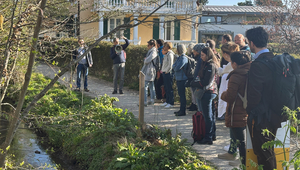Initiative de recherche Blue-Green Biodiversity
Une collaboration entre l'Eawag et le WSL consacrée à la biodiversité à l'interface des écosystèmes aquatiques et terrestres
Graphique: Les milieux naturels bleu-vert sont des hotspots de biodiversité
Les écosystèmes aquatiques et terrestres sont étroitement liés et s’enrichissent réciproquement. Ces hotspots ou points chauds de biodiversité sont toutefois menacés par des modification d’origine humaine tels que le changement climatique, l’urbanisation ou l’intensification de l’agriculture. Le graphique suivant illustre les interactions entre l’eau et la terre et les questions sur lesquelles porte l’initiative de recherche BGB.
Comment la biodiversité évolue-t-elle ?
Sur toute la planète, la biodiversité connaît un déclin dramatique. L’initiative BGB étudie son évolution dans l’espace et dans le temps, au niveau local bien sûr, par exemple le long de la Thur en Suisse, mais aussi au niveau mondial à l’aide de données archivées et d’images satellitaires, sur une échelle temporelle allant de quelques décennies à plusieurs millions d’années.
Qu’est-ce qui influence la diversité des espèces ?
Les nouvelles affectations des sols découlant de l’intensification de l’agriculture ou de l’urbanisation, du changement climatique, de la surexploitation des ressources naturelles ou de l’apparition d’espèces envahissantes modifient les milieux naturels et menacent la biodiversité. L’initiative BGB étudie l’impact de ces différents facteurs.
Quelles sont les relations entre écosystèmes terrestres et aquatiques ?
Sur terre et dans l’eau, les écosystèmes sont étroitement imbriqués. Par exemple, en tombant dans l’eau, les feuilles nourrissent des micro-organismes. Ceux-ci sont dévorés par les larves prédatrices d’insectes qui quittent le milieu aquatique après leur dernier stade larvaire. Sur terre, ces insectes particulièrement nutritifs alimentent les oiseaux. L’initiative BGB examine ce réseau de biodiversité dans son ensemble.
Comment promouvoir et protéger la biodiversité ?
L’initiative BGB vise à élaborer des recommandations pour la pratique et la politique afin de stopper ou au moins de réduire la perte de biodiversité aussi rapidement que possible. Comment relier les milieux naturels dans les agglomérations par une infrastructure bleu-vert ? Ou encore, à quoi ressemble une politique efficace de biodiversité ?
News
Blue-Green Biodiversity
La biodiversité est essentielle à la vie et au bien-être des populations humaines. La perte de biodiversité est, avec le changement climatique, l'un des plus grands défis auxquels l'humanité est confrontée. La recherche et les mesures pour inverser et atténuer la perte de biodiversité et celle des fonctions et services écosystémiques qui lui sont associés sont donc indispensables. Afin d'aborder cette urgence scientifique et sociale, le Conseil des EPF a financé l’initiative de recherche Blue-Green Biodiversity (BGB, biodiversité bleu-vert), c'est-à-dire la diversité biologique à l'interface de l'eau et de la terre. Cette initiative a pour objet de renforcer la recherche interdisciplinaire sur la biodiversité au sein du WSL et de l'Eawag, mais aussi dans l'ensemble du domaine des EPF et au-delà, afin de comprendre et de relever le plus rapidement possible les défis liés à la disparition d'espèces et aux modifications de la biodiversité.
Phase 2: BGB 2021–2025
En 2021, des projets de recherche à plus long terme ont été lancés, notamment de nouvelles expériences, des études de terrain et de la collecte de données. Cinq projets de recherche et trois projets de mise en œuvre visent à approfondir les thèmes de BGB 2020, ainsi qu'à mettre en place de nouvelles recherches de pointe et à aborder des questions appliquées pour lesquelles il n'existe pas encore de données. Les questions de recherche ciblées seront scientifiquement stimulantes et directement pertinentes pour des applications pratiques et/ou des actions de vulgarisation.
Principaux objectifs pour 2021 à 2025
- Former une cohorte de chercheuses et chercheurs en début de carrière sur des sujets liés à la biodiversité.
- Développer et tester des modèles de modification de la biodiversité.
- Renforcer les capacités de conception, de mise en œuvre et de gestion des mesures de conservation et de restauration de la biodiversité.
- Sensibiliser et traduire les résultats pour les communiquer aux professionnelles et professionnels de la pratique et au grand public.
Liste des projets BGB financés en 2023 - 2025
Bleu: Projets de recherche et de formation avec un doctorat
Gris: Projets de mise en œuvre
| Projet 1 | Inter- and transdisciplinary integration at the interface between science, policy and practice: Empirical insights from the BGB Research Initiative |
| Projet 2 | Gaps within and between International and National Biodiversity Policy Direction du projet: PD Dr. Manuel Fischer (Eawag) et PD Dr. Catherine Graham (WSL) Postdoc: Dechen Lham |
| Projet 3 | Integrating biodiversity standards into local planning: The case of Swiss municipalities Direction du projet: Prof.h.c. Dr. Anna Hersperger (WSL), Prof. Dr. Rolf Holderegger (WSL), Dr. Marco Moretti (WSL) et Prof. Dr. Florian Altermatt (Eawag) Collaboratrice scientifique: Stephanie Schwab (WSL) |
Liste des projets BGB financés en 2021 - 2024
Bleu: Projets de recherche et de formation avec un doctorat
Gris: Projets de mise en œuvre
| Projet 1 | Blue-green stormwater infrastructure meets biodiversity in the city (Benefit) Direction du projet: Dr. Lauren Cook (Eawag) et Dr. Marco Moretti (WSL) Postdoc: Andreas Dietzel PhD student: Kilian Perrelet Coopération: João P. Leitão (Eawag), Florian Altermatt (Eawag), Nicole Bauer (WSL), Anna Hersperger (WSL) |
| Projet 2 | Food-webs across aquatic-terrestrial environments in forests in the face of climate change Direction du projet: Prof. Dr. Martin Gossner (WSL) et Prof. Dr. Carsten Schubert (Eawag) Postdoc: Maja Ilic PhD student: Bastiaan Drost Coopération: Marco Moretti (WSL), Marco Lehmann (WSL), Matthias Saurer (WSL), Catherine Graham (WSL), Loïc Pellissier (WSL), Florian Altermatt (Eawag), Jakob Brodersen (Eawag), Blake Matthews (Eawag), Anita Narwani (Eawag), Ole Seehausen (Eawag), Christoph Vorburger (Eawag), Andreas Bruder (SUPSI) |
| Projet 3 | Species interactions in beaver engineered habitats link let-water ecosystem processes Direction du projet: PD Dr. Anita Risch (WSL) et Dr. Francesco Pomati (Eawag) Postdoc: Leonardo Capitani PhD student: Valentin Moser Coopération: Aline Frossard (WSL), Steffen Boch (WSL), Chris Robinson (Eawag), Christof Angst (Biberfachstelle CH), Thomas Kreienbühl (Ecqua), Silvan Minnig (umweltbildner.ch) |
| Projet 4 | Blue-Green Cyanobacteria: Diversity, Toxins et alpine Tourism Direction du projet: Prof. Dr. Christoph Scheidegger (WSL) et Dr. Elisabeth Janssen (Eawag) Postdoc: Francesca Pittino PhD student: Juliana Oliveira Coopération: Sabine Fink (WSL) |
| Projet 5 | Assessing et designing blue-green conservation strategies for the 21st Century in Switzerland Direction du projet: Prof. Dr. Niklaus Zimmerman (WSL) et Prof. Dr. Ole Seehausen (Eawag) Postdoc: Wenna Ding PhD student: Oluwadamilola Ogundipe Coopération: Florian Altermatt (Eawag), Jakob Brodersen (Eawag), Anita Narwani (Eawag), Blake Matthews (Eawag), Loïc Pellissier (WSL), Catherine Graham (WSL), Rolf Holderegger (WSL), Martin Gossner (WSL), Kurt Bollmann (WSL), Michael Nobis (WSL), Philipp Brun (WSL) |
| Projet 6 | The let-water-scape: Capacity building across the blue-green interface Direction du projet: Florian Altermatt (Eawag) et Prof. Dr. Rolf Holderegger (WSL) Postdoc: Sabine Güsewell Coopération: divers scientifiques du programme BGB |
| Projet 7 | Enhancing residents’ understanding of blue-green biodiversity through participatory interventions et social learning: A key for successful river restoration planning and implementation Direction du projet: Dr. Matthias Buchecker (WSL) et Dr. Nadja Contzen (Eawag) Postdoc: Marius Fankhauser Coopération: Janine Bolliger (WSL), Christopher Robinson (Eawag) |
| Projet 8 | BlueGreenNet - Social-ecological networks to enhance biodiversity in peri-urban regions Direction du projet: Dr. Manuel Fischer (Eawag) et PD Dr. Janine Bolliger (WSL) Postdoc: Giulia Donati Coopération: Peter Bach (Eawag), Adrienne Grêt-Regamey (ETH), Sabine Hoffmann (Eawag), Achilleas Psomas (WSL), Francine van den Brandeler (Eawag) |
Phase 1: BGB 2020
BGB2020 a identifié un ensemble de questions fondamentales et comprend 13 projets de recherche subventionnés pour financer des boursiers post-doctoraux pendant un an. Ces projets ont fourni des résultats rapides en se concentrant sur l'analyse des données existantes pour répondre à des questions d'actualité dans le domaine des sciences fondamentales et appliquées de la biodiversité à l'interface de la biodiversité aquatique et terrestre.
Principaux objectifs de l'appel 2020
- Créer une communauté de recherche, observer les développements actuels (analyse prospective) et fixer des priorités pour établir de nouvelles collaborations et réagir à temps aux problèmes.
- Analyse des données existantes et modélisation pour mieux comprendre les similitudes et les interconnexions entre les systèmes aquatiques et terrestres
- Sensibilisation du grand public et transfert de connaissancse aux praticiens
Liste des projets BGB financés en 2020
| Projet 1 | The architecture of community structure, functional traits and trophic networks across blue-green ecosystems Direction du projet : Prof. Dr. Florian Altermatt (Eawag) et Prof. Dr. Loïc Pellissier (WSL) Postdoc: Hsi-Cheng Ho Coopération: Jakob Brodersen (Eawag), Martin Gossner (WSL), Catherine Graham (WSL), Ole Seehausen (Eawag), Niklaus Zimmermann (WSL) |
| Projet 2 | Blue-green infrastructure for blue-green lives: modelling use and colonization credit of an ecological infrastructure to inform evidence-based amphibian conservation Direction du projet : Dr. Ariel Bergamini (WSL) et Prof. Dr. Christoph Vorburger (Eawag) Postdoc: Helen Moor Coopération: Simon Egger (canton of Aargau), Rolf Holderegger (WSL), Benedikt Schmidt (info fauna karch & UZH) |
| Projet 3 | Analysing recent developments in abundance, biomass and species richness of aquatic and terrestrial insects in Switzerland Direction du projet : Dr. Kurt Bollmann (WSL) et Dr. Nele Schuwirth (Eawag) Postdoc: Friederike Gebert Coopération: Martin K. Obrist (WSL), Florian Altermatt (Eawag) |
| Projet 4 | Contrasting patterns and processes of biological invasions in blue versus green ecosystems Direction du projet : Dr. Eckehard Brockerhoff (WSL) et Dr. Marco Baity-Jesi (Eawag) Postdoc: Agnieszka Sendek Coopération: Florian Altermatt (Eawag), Martin Bader (WSL), Martin Gossner (WSL), Martin Obrist (WSL), Andrew Liebhold (US Forest Service / CULS), Hanno Seebens (Senckenberg Biodiv. & Climate Res.), Piet Spaak (Eawag), Christoph Vorburger (Eawag), Thomas Wohlgemuth (WSL) |
| Projet 5 | Testing the generality of biotic homogenization by human impact in aquatic and terrestrial ecosystems Direction du projet : Dr. Martin M. Gossner (WSL) et Prof. Dr. Florian Altermatt (Eawag) Postdoc: Mark Wong Coopération: Jakob Brodersen (Eawag), Catherine Graham (WSL), Heike Lischke (WSL), Marco Moretti (WSL), Loïc Pellissier (WSL), Ole Seehausen (Eawag), Thomas Wohlgemuth (WSL), Niklaus E. Zimmermann (WSL) |
| Projet 6 | Evaluating temporal community structure as a function of environmental variables acting at different scales Direction du projet : Prof. Dr. Catherine Graham (WSL) et Dr. Blake Matthews (Eawag) Postdoc: Shyamolina Ghosh Coopération: Martin Gossner (WSL), Heike Lischke (WSL), Anita Narwani (Eawag), Christian Rixen (WSL), Ole Seehausen (Eawag), Sarah R. Supp (Denison University), Thomas Wohlgemuth ( WSL), Niklaus E. Zimmermann (WSL) |
| Projet 7 | How has Swiss biodiversity policy been performing over the last 30 years? Direction du projet : Prof. Dr. Felix Kienast (WSL) et Dr. Manuel Fischer (Eawag) Postdoc: Ueli Reber Coopération: Rolf Grütter (WSL), Anna Hersperger (WSL), Karin Ingold (Eawag), Olga Koblet (Univ. Zürich), Ross Purves (Univ. Zürich) |
| Projet 8 | Predator coupling of aquatic and terrestrial ecosystems: the importance of nutritional diversity of prey Direction du projet : Dr. Blake Matthews (Eawag) et Prof. Dr. Catherine Graham (WSL) Postdoc: Ryan Shipley Coopération: Jakob Brodersen (Eawag), Martin Gossner (WSL), Ryan Shipley (MPI-AB), Christine Weber (Eawag) |
| Projet 9 | Blue-green infrastructure for biodiversity enrichment in human-dominated landscapes Direction du projet: Prof. Dr. Max Maurer (Eawag) et Dr. Janine Bolliger (WSL) Postdoc: Giulia Donati Coopération: Peter Marcus Bach (Eawag), Achilleas Psomas (WSL) |
| Projet 10 | Warming-related community turnover in terrestrial and freshwater ecosystems Direction du projet : Dr. Anita Narwani (Eawag) et Dr. Christian Rixen (WSL) Postdoc: Imran Khaliq Coopération: Jakob Brodersen (Eawag), Martin Gossner (WSL), Catherine Graham (WSL), Blake Matthews (Eawag), Loïc Pellissier (WSL), Francesco Pomati (Eawag), Ole Seehausen (Eawag), Florian Zellweger (WSL), Niklaus E. Zimmermann (WSL) |
| Projet 11 | Global remotely sensed phenology: A unifying Essential Biodiversity Variable for assessing the linkage between aquatic and terrestrial ecosystems Direction du projet : Dr. Daniel Odermatt (Eawag) et Dr. Yann Vitasse (WSL) Postdoc: Jelle Lever Coopération: Alexander Damm-Reiser (University of Zurich), Petra D’Odorico (WSL), Arthur Martin Gessler (WSL), Luis Gilarranz (Eawag), Christian Ginzler (WSL) |
| Projet 12 | Biodiversity assembly in blue and green ecosystems: speciation versus immigration Direction du projet : Prof. Dr. Ole Seehausen (Eawag) et Prof. Dr. Niklaus E. Zimmermann (WSL) Postdoc: Luiz Jardim de Queiroz Coopération: Florian Altermatt (Eawag), Jakob Brodersen (Eawag), Catherine Graham (WSL), Blake Matthews (Eawag), Loïc Pellissier (WSL), Lukas Rüber (NMBE) |
| Projet 13 | Assessing richness differences between blue and green systems by quantifying biodiversity turnover along global gradients |
Liste des projets associés à BGB
Biodiversity change in a warming world
Responsible de projet: Anita Narwani (Eawag), Co-Pl: Christian Rixen (WSL)
Postdoc: Imran Khaliq (Eawag)
Durée: 01.01.2022 - 31.05.2022
Organe de financement: Eawag's Academic Transition Grant
Rezente Entwicklungen in der Vielfalt und Abundanz aquatischer Insekten in der Schweiz (Recent developments in richness and abundance of aquatic insects in Switzerland)
Responsible de projet: Kurt Bollmann (WSL) Co-Pl: Nele Schuwirth (Eawag)
Postdoc: Friederike Gebert
Durée: 01.10.2021 - 30.06.2022
Organe de financement: FOEN (Yael Schindler)
Global analysis of the phenology of supply and demand for n-3 long-chain polyunsaturated fatty acids in consumer diets and its relationship to consumer fitness
Responsible de projet: Blake Matthews, Daniel Odermatt, and J. Ryan Shipley (Eawag)
Durée: 01.09.2021 - 30.08.2022
Collaborateurs:
Luis J. Gilarranz (Eawag), Cornelia Twining (Eawag), Jelle Lever (WSL), Catherine Graham (WSL) and Yann Vitasse (WSL)
Organe de financement: Eawag
Living Lab Bern: Establishing a pre-urbanisation baseline
Responsible de projet: Max Maurer (Eawag)
Co-responsible de projet: Lauren Cook, Peter M Bach, João Leitão (Eawag)
Durée: 09.2021 - 09.2022
Collaborateurs:
Marco Moretti, Janine Bolliger, Anna Hersperger, Matthias Buchecker (WSL), Nadja Contzen, Manuel Fischer (Eawag), Stephanos Anderski, Frank Marti, Judith Dobmann (Stadt Bern)
Organe de financement: Eawag
Biodiversity assembly in blue and green ecosystems: speciation versus immigration
Responsible de projet: Ole Seehausen (Eawag)
Co-responsible de projet: Niklaus Zimmermann (WSL)
Postdoc: Luiz Jardim de Queiroz
Durée: 01.09.2021 – 31.06.2022
Collaborateurs:
Carmela Dönz, Soraya Villalba, Roman Alther, Špela Borko, Ian R. McFadden, Thomas Schmitt, Florian Altermatt, Jakob Brodersen, Martin Gossner, Catherine Graham, Blake Matthews, Loïc Pellissier, Lukas Rüber
Organe de financement: Eawag
BIOMONDO - Towards Earth Observation supported monitoring of freshwater biodiversity
Responsible de projet: Petra Philipson, coordinator (Brockmann Geomatics)
Postdoc: Jelle Lever
Durée: 2021-2023
Collaborateurs:
Daniel Odermatt (Eawag), Consortium of Brockmann Geomatics, Brockmann Consult, Eawag, PBL, and Deltares
Organe de financement: European Space Agency
Seasonal changes and recovery from extreme climatic events as indicators of ecosystem stability and impending regime shifts
Responsbile de projet: Jelle Lever (WSL)
Co-responsible de projet: Yann Vitasse & Arthur Gessler (WSL)
Durée: 2021-2022
Organe de financement: SwissForestLab
GreenCityNet-Social-ecological networks to enhance biodiversity in urban green spaces
Responsbile de projet: Janine Bolliger (WSL)
Co-responsible de projet: Manuel Fischer (Eawag)
Durée: 2022-2025
Organe de financement: SNF
Publications et distinctions
Publications pour stakeholders
Publications scientifiques
Reber, U., Fischer, M., Ingold, K., Kienast, F., Hersperger, A., & Grütter, R. (2021). Die vielen Gesichter der Biodiversitätspolitik. Hotspot, 44, 9.
HOTSPOT 44.2021 deutsch WEB 31.10.2021.pdf (scnat.ch)
Roth L., Bolliger J., Donati G. 2021. Auswirkungen von zukünftigen Landnutzungsszenarien auf Amphibien im Kanton Aargau. N+L Inside 3/21.
Distinctions
Blue-Green Biodiversity
Initiative de recherche de Eawag & WSL
| |  |
Contacts
Co-direction de l'initiative

Prof. Dr. Catherine Graham
WSL
Tel. +41 44 739 23 61
Coordinatrice scientifique
Rétrospective de la Journée d'infEau spéciale 2024
Identifier, préserver et promouvoir la biodiversité bleue-verte
Programme, présentations et photos
Blue-Green Biodiversity dans les médias
Wie Biber Fauna und Flora verändern
Reportage radio de la SRF à partir de 18:27.




